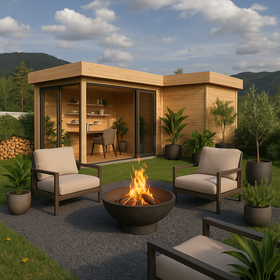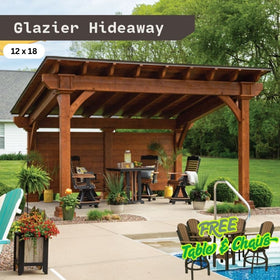512-777-0154

The Guide to a She Shed You Can Live In: Plans, Permits, and Design
There’s something magical about having your own backyard hideaway. A place where you can read, create, or just sit in silence with a cup of tea. That’s what makes a she shed you can live in so appealing.
It’s more than a shed. It’s a livable, stylish space that combines comfort, personality, and practicality. Let’s break down how to build one that checks all the right boxes, from zoning laws to décor.
What is a "Live-In" She Shed? Defining the Difference
A live-in she shed isn’t just a cute backyard escape. It’s a functional, cozy dwelling that’s designed for actual living, complete with utilities, insulation, and a touch of personality.
Think of it as the middle ground between a backyard studio and a tiny home. You can work there, nap there, or host your best friend for the weekend.
She Shed vs. Tiny House vs. ADU (Accessory Dwelling Unit)

All three are small, self-contained spaces, but their purposes differ:
- She Shed: A personal escape. Think reading nook, craft room, or mini office that can evolve into a livable space.
- Tiny House: Built for full-time living and designed with every home necessity in mind.
- ADU: A legal residential unit that can be rented out or used as guest housing.
Your she shed sits somewhere in between: a creative retreat that can become livable with the right upgrades.
Key Amenities That Make a She Shed Truly Livable
To make it truly livable, add the basics of comfort:
- Proper insulation and climate control
- Electricity for lights and outlets
- Plumbing for a bathroom or a small kitchen
- Sleeping area or convertible bed
- Smart storage and functional furniture
A few upgrades can turn a pretty shed into a real home.
Understanding the Appeal of a Backyard Dwelling
People love she sheds because they offer freedom and peace. You get a quiet space without leaving your property. For some, it’s a weekend retreat. For others, it’s a full-time creative hub.
It’s privacy without distance, a small slice of independence right outside your door.
The Critical First Step: Navigating Permits and Zoning
Before you start sketching floor plans, you’ll need to tackle the not-so-fun part: local rules. Every area has its own zoning laws and building codes, and they decide what you can and can’t build.
1. Understanding Local Building Codes for Habitable Structures
Building codes exist for a reason: they keep you safe. These rules cover things like:
- Maximum size and height
- How far your shed must be from fences and neighbors
- Proper exits, fire safety, and ventilation
Check with your local building office before you lay the first board. It’s easier than tearing it down later.
2. Foundation Requirements for Permanent Residences
The foundation sets the tone for your project.
- A pier-and-beam setup works for small, semi-portable sheds.
- A concrete slab adds stability and better insulation.
- A crawl space or basement offers long-term comfort and room for plumbing.
Pick a base that matches your shed’s purpose and local soil conditions.
3. Essential Utility Hook-ups and Inspections
Electricity, plumbing, and HVAC all need licensed professionals. It’s not just about convenience, it’s about safety. Once installed, you’ll go through inspections to confirm your shed meets all residential standards.
4. Insurance and Property Tax Implications
Turning your shed into a living space may raise your insurance or property taxes. Contact your provider to understand what’s covered. It’s better to know early than to get an unexpected bill later.
Designing Essential Systems for Year-Round Living
A true livable she shed needs systems that work through every season. That means planning for heat, cooling, and water before the decorating begins.
1. Electrical Wiring: From Lighting to Major Appliances

Add more outlets than you think you’ll need. Plan for lamps, a mini fridge, a laptop, and maybe a microwave. If you’re going eco-friendly, solar panels can power your shed efficiently and reduce long-term costs.
2. Planning for Plumbing: Installing a She Shed Bathroom and Kitchenette
Even a small bathroom makes your shed feel like home. Compact sinks, composting toilets, and tankless water heaters save space. If you’re adding a kitchenette, consider a mini sink and a small cooktop.
3. Heating, Cooling, and Insulation for a Four-Season Retreat
Comfort starts with insulation. Spray foam or rigid board keeps temperatures steady. A ductless mini-split system like Senville 9000 BTU Concealed Duct Air Conditioner - Heat Pump - SENA/09HF/ID, works wonders for heating and cooling in tight spaces. Add ceiling fans and blackout curtains to help regulate temperature.
4. Water and Waste Management Solutions (Septic vs. Sewer)
In rural areas, a septic system or composting toilet may be your best bet. Urban builds can usually connect to the main sewer line with city approval. Make sure your drainage is efficient; standing water is no one’s friend.
Live-In She Shed Ideas: Inspiration and Function
There’s no single way to design your she shed. It should match your lifestyle, personality, and needs. Here are a few popular ideas that blend beauty with practicality.
1. The Luxurious She Shed Guest House (or Casita)
Perfect for guests or visiting family. Add a comfy bed, a small kitchenette, and soft lighting. It’s private, cozy, and might earn you the title of “best host ever.”
2. The Tiny Home Conversion: Making a She Shed Your Full-Time Dwelling
Turn your she shed into a complete tiny home with a loft bed, a compact kitchen, and clever storage. It’s minimal living at its finest, simple, efficient, and surprisingly comfortable.
3. Dual-Purpose Designs: Office and Occasional Bedroom
Many people blend work and rest. A sofa bed and fold-down desk let your office double as a guest room. You’ll love the flexibility, especially during holidays.
4. Smart Space-Saving Design and Multifunctional Furniture
Murphy beds, ottomans with hidden storage, and foldable tables make every square foot count. With the right design, even a 200-square-foot shed can feel spacious.
Building Your Live-In She Shed: DIY, Kits, or Custom
Now it’s time to decide how you’ll build it. Your choice depends on your budget, skills, and how hands-on you want to be.
Comparing Prefabricated She Shed Kits for Residential Use
Prefabricated kits are quick to assemble and often customizable. They’re great for beginners, but not all are rated for full-time living. Look for insulated walls and roofs that meet residential standards.
Finding the Right She Shed Plans and Blueprints
Detailed plans make your build smoother. They outline floor layouts, foundation specs, and utility placements. Some companies sell blueprints already approved for residential use, saving you time with permits.
Hiring Contractors vs. Managing a DIY Build
DIY builds save money but take patience and skill. Hiring professionals ensures everything meets code. Many homeowners do both, build the shell themselves, then hire electricians and plumbers for the technical work.
Interior Design: Making Your Dwelling a Home

Once the structure is up, the fun begins. It’s time to add character, comfort, and charm.
Maximizing Natural Light and Views with Windows and Doors
Large windows and glass doors make your shed feel airy and open. Skylights are another great way to brighten a small space while keeping privacy intact.
Decorating for Comfort: Creating a Cozy, Personalized Retreat
Soft rugs, layered blankets, and warm lighting instantly make a space feel inviting. Add a few plants or framed photos for that lived-in look that says, “This is my happy place.”
Outdoor Living Integration: Patios and Decking
A small deck or patio extends your living area outdoors. Add a café table or hammock, and you’ve got a perfect setup for morning coffee or sunset chats.
So, Can You Really Live in a She Shed?
Yes, you absolutely can. A she shed you can live in is a real, livable structure when it’s built to code and designed with care.
It’s not just an extension of your home, it’s a lifestyle choice. With a little planning and creativity, your backyard can hold the most peaceful part of your entire property.





